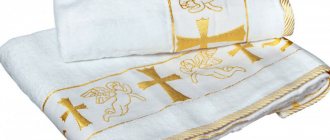Aerobaptism - Greek tradition of lay baptism
Share
Baptism is the only sacrament of the Orthodox Church that can be performed not by a priest, but by a layman. This is only possible in an exceptional situation, when, for example, an unbaptized person, dying, wants to become a Christian, but there is no clergyman nearby. In this case, baptism can be performed by an Orthodox layman. To do this, he needs water, as well as knowledge of the baptismal formula: “The servant of God such and such (the person’s name is called) is baptized in the name of the Father. Amen. And the Son. Amen. And the Holy Spirit. Amen". Baptism performed by a layman is recognized by the Church as legal. And if a person baptized in this way survives, he must turn to the priest. He will no longer perform the sacrament again, but will complete it by reading certain prayers and, of course, performing the sacrament of confirmation.
The lack of water is not a fundamental obstacle to baptism. In an extreme situation, water can be replaced with any acceptable liquid (juice, for example) or bulk substance. Sand is quite suitable for this purpose. But how surprised I was when I learned that in the Orthodox Churches of the Greek tradition: Constantinople, Greece and others, lay baptism can be performed with the help of... air. This rite even has its own special name - Aerobaptism. That is, baptism by air. Previously, aerobaptism was performed in Greece on an infant who was in a serious state of health. Nowadays, air baptism happens to almost every Greek child. Technically, aerobaptism looks like this. The baby (usually the mother) is picked up and lifted up three times or slightly tossed. At the same time, she pronounces the already mentioned baptismal formula: “The servant of God such and such (the person’s name is called) is baptized in the name of the Father. Amen. And the Son. Amen. And the Holy Spirit. Amen".
Aerobaptism is usually performed right in the maternity hospital. Immediately after the baby was brought to his mother’s room. How so? - you ask. It turns out that real baptism with water is no longer performed in Greek churches because of Aerobaptism? But this is the peculiarity of Aerobaptism, that this rite does not cancel real baptism. Aerobaptism is considered by the Greeks to be a form of oikonomia (justified deviation from the accepted norm due to external circumstances). Orthodox Greeks believe that if a child who has been baptized by air dies, he is considered a full-fledged Orthodox Christian. If he survives, then Aerobaptism does not in any way prevent him from being fully baptized in a church, where the priest will immerse him three times with prayer in holy water.
Aerobaptism is a unique phenomenon for the Orthodox world, which is found only in Greek Churches. The clergy and Greek theologians explain this rite as “baptism by intention,” which the Lord, they believe, does not reject. As proof of the correctness of their position, they cite examples of ancient martyrs, some of whom were not baptized, but, indicating only the intention to become a Christian, were executed by pagans. By performing Aerobaptism, Orthodox Hellenes thereby again indicate their intention to baptize a child in the future. If he does not live to see the sacrament itself, it is believed that the intention is enough to consider the deceased baby a baptized Orthodox Christian and, accordingly, remember him at the service.
Baptism by midwife
I only read about baptism by someone other than a priest.
Imagine my surprise when in one register book I came across 3 unusual entries at once! In January and twice in March, the babies were baptized by the midwife.
Here is an example of such a note to the metric record of the birth of Mikhail Golovin on March 10, 1914. It is indicated that the baby was baptized by a midwife.
Metric record of the birth and sacrament of baptism on March 10, 1914 of the baby Michael. It is indicated that it was loaded by a peasant grandmother from the village of Taparki-Burovoy.
Did Jesus Christ Himself baptize?
Blessed Theophylact of Bulgaria: “When you hear that He baptized, do not think that He Himself baptized: His disciples baptized, but the evangelist attributes the work of the disciples to the Teacher. Further, this same evangelist says that “Jesus did not baptize, but his disciples” (John 4:2). Will you ask “why didn’t He baptize Himself”? Find out. John first said that “He will baptize you with the Holy Spirit” (Matt. 3:11). But He did not give the Holy Spirit yet, because it was not yet time. So, if He had baptized, then either He would have baptized without the Spirit (and how then would He have differed from John?), or He would have given the Spirit ahead of time, and this is unworthy of God, who does everything on time. When was the time to give the Spirit? Time after the ascension.” Source
Who Baptized the Apostles and the Virgin Mary?
— John Moschus recorded in the Spiritual Meadow: “After all, it is not written about the apostles that they were baptized. Will they really not enter the kingdom of heaven? - No! - they answered this. — The apostles were baptized, as Clement Stromateuth says about this in the fifth volume of his “Hypotyposes.” Explaining the word of the apostle: “I thank God that I did not baptize any of you,” he says: “Christ, they say, baptized only Peter, Peter - Andrew, Andrey - James and John, and these - the rest." (Blessed John Moschus Spiritual Meadow.176) - Saint Sophronius of Jerusalem and on the basis of the Tradition kept in the Jerusalem Church testifies: “Our Lord Jesus Christ baptized Peter with His own hands, and Peter, in turn, baptized Andrew, James and John; James and John baptized the other Apostles. The Apostles Peter and John baptized the Mother of God together” (Fragmentum. De baptismate apostolorum. – Migne. PG.87/3, col.3372). — Synaxarion of the Colored Triodion for the Ascension of the Lord: “Epiphanius of Cyprus narrates: as the Theologian John baptized the Mother of God, and Peter was the same and the rest of the apostles” (Tsvetnaya Triodion, ed. in the 6th year of Patr. Joseph, fol. 451 vol.). — Rev. Ephraim the Syrian: “What should I call You?... Will I call You the Bridegroom or the Lord, Who gave birth to His Mother by a new Birth in the waters.” And here she answers from the Person of the Mother of God: “I am a Slave and a Daughter, because You bought Me and baptized Me in the waters... And just as I gave birth to Him by a new Birth in the flesh, so He gave birth to Me by a second Birth” (Venerable Ephraim the Syrian. Hymns for the Nativity of Christ, paragraph 10 // Creations, vol. 5, paragraph 151, p. 148). — Tertullian in the word “On Baptism”: “If they (i.e., the Apostles) accepted the human baptism of John, then they also desired the Lord’s Baptism, why did the Lord Himself call for a single Baptism, saying to Peter, who did not want to be betrayed: “Whoever is once betrayed, has no need for this again” (John 13:6), which, of course, He would not say to someone who was not baptized.”
What to do if the name of the person being baptized is not in the calendar?
If the name of the person being baptized is not in the calendar, during Baptism the person will be renamed in order to gain an Orthodox heavenly patron. In this case, a person’s name can be double: one for everyone and for general use, and the other for religious life. At Baptism, the name that is closest in sound is chosen. So, Yana is most often baptized with the name John, Ilona or Nelly - Elena. Some names in the church tradition have a different sound, for example, Svetlana is Photinia (from the Greek photos - “light”), and Victoria is Nike, both names mean “victory” in Latin and Greek. However, you can choose a name for yourself that is not necessarily consonant with the worldly name of the person being baptized.
Who is the midwife?
Midwife, midwife - a woman who helped a woman in childbirth, and then washed the baby and looked after him for several days after birth.
Her duties included cutting the umbilical cord and then washing the baby.
Different regions of the Russian state had their own traditions. For example, in the central part of Russia, it was necessary to cut a boy’s umbilical cord on an oak board or an ax handle, and for a girl on an alder board or spindle. The belief assumed that the boy would be an excellent craftsman, and the girl an excellent needlewoman.
The midwife tied the umbilical cord with a linen thread intertwined with a few hairs from the parents.
About the fear of being baptized
Back in the fourth century, many residents of Byzantium refused to accept Baptism, citing the fact that they would not be able to give up their usual way of life, favorite activities and hobbies. And it was not just anyone but Saint John Chrysostom himself who convinced people at that time that Christian life according to the Gospel would not require such a radical renunciation from them: “...Why are you running away? So, you say; I cannot keep the commandments. But did God command the impossible? <...>Aren't you allowed to do business? Am I distracting you from your wife? I only keep you from committing adultery. Is it from the use of property? From covetousness only and theft. Am I forcing you to give everything away? Give only a little, as far as possible, to those in need. <…> Are we forced to fast? We only prohibit indulging in intoxication and satiety. We eliminate that which causes dishonor to you, which you yourself, even here, before Gehenna, already recognize as shameful and hateful. Do we forbid having fun and rejoicing? If only it wasn’t shameful and dishonorable.”
Symbolism of the sacrament
Each element of the rite in the Orthodox sacrament of baptism expresses a person's dedication to Jesus Christ.
Each element of the ritual in the Orthodox sacrament of baptism expresses a person's dedication to Jesus Christ. For example, cutting hair in the Greco-Roman world was a sign of slavery to man, and in the sacrament of baptism, cutting a lock of hair signifies worship before God. The pectoral cross , which is hung on the neck of the person being baptized, should remind of Christ’s feat on the cross, the duty of a Christian and the commandments of the Savior:
If anyone wants to come after Me, let him deny himself and take up his cross (Matthew 16:24)
The meaning of this reminder is to help the baptized person overcome selfishness, pride, lust, laziness, fear and come closer to the love with which Christ loved man and the world. The white shirt in which the baptized person is clothed means the purity of life in Christ, the transformation of man by the Divine Light; the candle in his hand is spiritual enlightenment, the light of joy.
Baptism is a spiritual birth - after baptism and confirmation, you can begin all the other sacraments of the Church.
The fruit of a person’s Baptism should be that he stops living for himself and begins to live for Christ and other people, gaining the fullness of life in this. A necessary condition for the acceptance of this great Sacrament by an adult is firm faith and repentance for all sins committed before Baptism. By this Sacrament the person baptized is introduced into the Church and becomes a member of it. A person who has become a Christian must decisively be reborn according to the word of the Lord, who said: If you love Me, keep My commandments (John 14; 15). And He promised such: If you keep My commandments, you will remain in My love (John 15:10).
Do adults need godparents?
Godparents, or godparents, are only required for children (under 14 years of age); for adults, godparents are not required. When an adult is baptized, he himself can confess his faith in Jesus Christ and wants to accept Holy Baptism to live according to His will. But since most people are baptized in infancy, when the child does not yet have a conscious faith and cannot publicly confess it, godparents do this for him. Thus, children are baptized according to the faith of their recipients and according to the faith of their parents.
Is it possible to be baptized if it is not known whether you have been baptized before?
“If it is unknown about the baby whether he was baptized (that is, there are no witnesses who could accurately report this), he can be baptized in the usual manner without any restrictions (Carth. 72; Trul. 84). Based on the same rule, it is permitted to baptize foundlings.” Orthodox encyclopedia. Volume 38. M., 2015. P. 656.
“If an adult who wishes to be baptized does not know whether he was baptized in infancy, and there is no way to inquire about this, then the priest should baptize him, since a second Baptism out of ignorance is not imputed to the person being baptized. The same should be done in cases where the baby was allegedly baptized by a layman, but it was not possible to establish whether the Sacrament was performed correctly. In some regions of Russia, in such dubious cases, the so-called “conditional Baptism” is performed, in which the words “if you are not baptized” are added to the sacramental formula. This form of Baptism is offered by the Breviary of Metropolitan Peter Mohyla. However, according to experts in the field of liturgical theology, the ancient Church did not know conditional Baptism. Among Catholics, conditional Baptism has become a custom since ancient times.” A clergyman's handbook. T. 4. M., 1983. P. 236.











